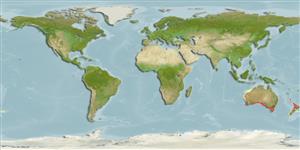Environment: milieu / climate zone / depth range / distribution range
экология
морской демерсальный; пределы глубины 45 - 288 m (Ref. 54394). Temperate
Eastern Indian Ocean to Southwest Pacific: off southeastern and southern and southwestern coasts of Australia.
Size / Вес / Возраст
Maturity: Lm ? range ? - ? cm
Max length : 35.0 cm TL самец/пол неопределен; (Ref. 33839)
Краткое описание
морфология | морфометрия
колючие лучи спинного плавника (общее число): 8; членистые (мягкие) лучи спинного плавника (общее число): 8; колючие лучи анального плавника 3; членистые (мягкие) лучи анального плавника: 5. Diagnosis: Dorsal rays XIII, 8 (7 or 9 in 3 of 48 specimens), fourth spine longest. Anal rays III, 5 (6 in 1 of 48 specimens). Pectoral rays 18-21 (mode 20), distal margin nearly rounded. Pored lateral-line scales 31-38 (35); longitudinal scale series 50-59 (54); scale rows between base of last dorsal spine and lateral line 6 or 7 (7). Well-developed gill rakers on upper limb 1, lower limb 4-6 (5), total 5-7 (6); rudimentary gill rakers on upper limb 3-5 (4), lower limb 3-8 (5). Swimbladder bilobed anteriorly (length 19% of SL, width 28% of SL, bilobed portion 67% of total swimbladder length). Dorsal profile of snout steep, forming angle of about 60-70° to horizontal axis of head and body. Nasal spine simple or with 2 points, directed upward or slightly forward, length of former approximately equal to or greater than anterior nostril diameter. Posterior margin of premaxilla ascending process just reaching level of anterior margin of posterior nostril when mouth closed. Interorbital ridge indistinct; no scales on narrow midinterorbital space, but scales present on supraorbital both above and below interorbital ridge; interorbital space deep, about one-fourth of orbit extending above dorsal profile of head. Preocular with a prominent pointed spine, its length greater than (rarely smaller) that of nasal spine, directed upward. Supraocular ridge with usually 2 prominent pointed spines (sometimes 3-7 spines), anterior spine with 1-5 points and posterior spine usually simple, canted laterally; supraocular ridge much closer to orbit than interorbital ridge in dorsal view. Sphenotic with 3-13 minute pointed spines. Postorbital spine flattened and serrated; occipital pit absent, nape flat, covered with scales entirely. Nuchal spine simple in young, with 2-5 points or serrated in adults; pterotic spine with 2-11 points; origin of nuchal spine slightly posterior to or just above that of pterotic spine, base smaller than that of latter. Upper posttemporal spine flattened and serrated; lower posttemporal spine with 1-4 points. Supracleithral spine with 1 or 2 points. Posterior margin of maxilla not reaching a vertical at posterior margin of orbit (usually extending beyond posterior margin of pupil); maxilla with scales extending posteriorly from between anterior and posterior lacrimal spines, but no scales on posterior margin. Underside of mandible smooth with 3 distinct pores on each side. Lacrimal ridge distinct with 4-9 points; anterior lacrimal spine simple, directed downward or slightly ventroposteriorly; posterior lacrimal spine with 1 or 2 points, directed downward or ventroposteriorly; length of anterior lacrimal spine 1.5 times or less in that of posterior lacrimal spine. Suborbital pit present, not deep; scales present on entire suborbital pit; suborbital ridge usually with 4 pointed spines in line with lacrimal ridge, directed backward, anterior 2 spines joined at bases and posterior 2 spines joined as bases, 1-3 spines sometimes arising from each suborbital spine; scales present between ventral margin of orbit and suborbital ridge; suborbital scales extending onto lower margin of eye membrane. Preopercle with 4 pointed spines (rarely 5 spines), 3 lower spines usually simple (sometimes with 2 or 3 points on each spine in larger specimens), lacking median ridge, uppermost spine with a median ridge and with a spine (sometimes 2 or 3 spines) distally; length of uppermost preopercular spine greater than pupil diameter. Upper opercular spine simple, lacking median ridge; lower opercular spine with a median ridge and usually with 1 or 2 spines (sometimes with 2 points each spine) arising from latter (opercular spine sometimes serrated); tip of lower opercular spine not extending beyond (rarely extending slightly beyond) opercular margin (Ref. 54394).
Occurs on the continental shelf (Ref. 9563); usually take below 100 m (Ref. 33839). Reported at depths of 20-260 (Ref. 9563).
Life cycle and mating behavior
половая зрелость | размножение | нерест | икра | Fecundity | личинки
Motomura, H., 2003. Revision of the scorpionfish genus Neosebastes (Scorpaeniformes: Neosebastidae), with descriptions of five new species. Indo-Pac. Fish. (37):46 p. (Ref. 54394)
Статус Красного Списка МСОП (Ref. 130435)
Использование человеком
дополнительная информация
народные названиясинонимыобмен веществхищникиэкотоксикологияразмножениеполовая зрелостьнерестSpawning aggregationFecundityикраРазвитие икры
Возраст/РазмерыростЗависимость между длиной и массой телаЗависимость между длинамиРазмерный составморфометрияморфологияличинкидинамика численности личинокпополнениечисленностьBRUVS
ссылкиаквакультура (рыбоводство)особенности рыбоводствастепень растяжениягенетикаElectrophoresesнаследуемостьболезниобработкаNutrientsMass conversion
соавторыизображенияStamps, Coins Misc.звукиCiguateraскоростьтип плаванияжаберная областьOtolithsмозгзрение
инструменты
Специальные отчеты
Скачать в формате XML
ресурсы в Интернет
Estimates based on models
Preferred temperature (Ref.
123201): 13.8 - 19.4, mean 15.5 °C (based on 64 cells).
Phylogenetic diversity index (Ref.
82804): PD
50 = 0.5002 [Uniqueness, from 0.5 = low to 2.0 = high].
Bayesian length-weight: a=0.01995 (0.00906 - 0.04395), b=3.01 (2.83 - 3.19), in cm total length, based on all LWR estimates for this body shape (Ref.
93245).
Trophic level (Ref.
69278): 3.8 ±0.5 se; based on size and trophs of closest relatives
Fishing Vulnerability (Ref.
59153): Low vulnerability (25 of 100).
